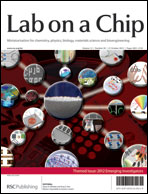Selective in situ functionalization of biosensors on LOC devices using laminar co-flow†
Abstract
Many applications involving lab-on-a-chip (LOC) devices are prevented from entering the market because of difficulties to achieve mass production and impart suitable properties allowing long-term storage. To integrate biosensors on these microfluidic chips, one of the main restrictions is the fabrication and stability of the molecular modifications that must be performed on the surfaces of the sensors for a given application. The complexity of the problem increases exponentially when the LOC integrates several of these sensors. Here we present a system based on laminar co-flow to perform an on-chip selective surface bio-functionalization of LOC-integrated sensors. This method has the advantage that the surface modification protocols are performed in situ before analyte detection. This approach reduces the burdens during LOC fabrication, keeping the required reagents stored outside of the detection structure in suitable wet conditions. The proof of concept is demonstrated through an optical characterization followed by electronic detection based on a novel differential impedance measurement setup. The system can be easily scaled to incorporate several sensors with distinct biosensing targets in a single chip.


 Please wait while we load your content...
Please wait while we load your content...